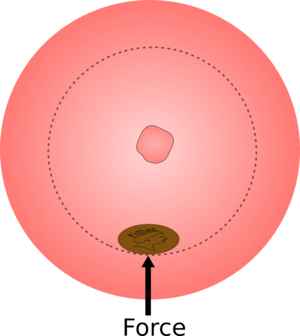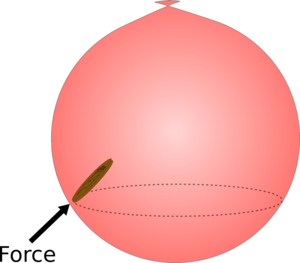Ingredients
| A balloon or two | Some different coins, nuts etc |
Instructions
Put a smooth coin, like a 1p, into the empty balloon, then inflate the balloon.
Swirl the coin around faster and faster, what happens to it?
Now try the same thing with a coin with rough milled edges like a 5p.
Try different objects like steel nuts, or other small rough (but not sharp) objects, and see how the sound changes.
Result
You should find that you can get the objects to roll around inside the balloon, almost horizontally.
If the object is rough it will make a noise as it rolls, the faster it goes and the more bumps there are on it the higher the pitch, and the bigger the bumps the louder it is.
Explanation
As you get the coin moving it starts to travel in a circle, naturally it would move in a straight line, so the balloon must be pushing it inwards. Because of its shape if the balloon is pushing inwards it must also be pushing upwards, so the coin moves up until this upward force is balanced by gravity. If you spin it faster it will climb higher.
 |  |
| For the coin to travel in a circle there must be an inward centripetal force. | This force must be pushing upwards as well because of the balloon's shape, so the coin is pushed up. |
What makes the strange noise?
The coin is whirling around very quickly. If it has a smooth edge it will just do that roll around, but if the coin or nut is rough it will bounce up and down as it rolls. As it does this it bounces the balloon's surface up and down.
 | A smooth coin rolls smoothly. |
|---|---|
 | A coin with a milled edge bounces up and down rapidly |
 | A nut bounces less quickly but much more. |
This vibration in the surface of the balloon is very efficiently transferred into the air by the balloon, a bit like small vibrations in a violin string being transferred to the air by the violin body.
The faster you whirl the object the faster the vibration and so the higher the pitch. If you use something with fewer sides like a coin the vibration is naturally slower so the pitch is lower, but the vibration is bigger so the sound is much louder.
a










Comments
Add a comment